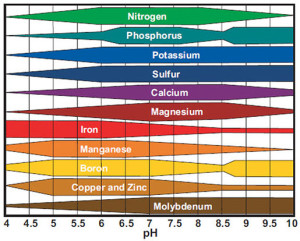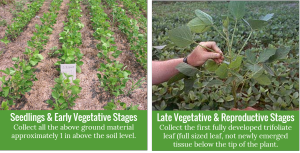If you heard Randy Dowdy at the Annual NC Commodities Conference this year then you probably heard him say:
“Don’t HOPE what’s going on, KNOW what’s going on.”
Do you know what’s going on in your soybean plants each year? Do your soils have adequate fertility and more importantly are the plants able to access the nutrients that are present? What is limiting your yields?
Despite soybeans being often thought of as a “hands-off” or “rotational” crop, they actually remove a large amount of nutrients from the soil compared to other crops. In order to have a high-yielding crop, you must be willing to fertilize for high yields. The table below shows the pounds of each nutrient required.

*While these quantities are high, this should not be interpreted as the amount of fertilizer to be added. Nutrient applications should vary according to soil type, residual nutrient status, and soil pH.
One of the ways that Randy Dowdy “knows instead of hopes” is through extensive soil and in-season tissue sampling. While correcting for fertility problems in-season through foliar applications is difficult, tissue sampling is still extremely valuable for learning what is limited at which point in the growing season. Understanding what nutrients are limited and when will help you make adjusts to achieve a higher yielding crop next season.
Soil testing is the best way to determine your fertilizer needs. However, just because a nutrient is in the soil doesn’t mean it’s available to the crop. For example, out of the several hundred tissue samples sent in to the NCDA lab for corn this year, over half were deficient in phosphorus. Is that because there isn’t enough P in these soils? Likely not, as most fields in NC are high in phosphorus. The problem is the P in the soil isn’t getting into these plants.
Both micronutrients and pH affect the uptake of our crop nutrients. Maybe the pH is too low or too high (see the soil pH and nutrient availability chart below) or maybe the phosphorus is not available because there are insufficient levels of boron or zinc or manganese (these elements are required for optimum P uptake).
Regardless of the cause of insufficient phosphorus in the plant, these growers figured it out because of in-season tissue sampling. Adding in-season tissue sampling to your management approach can help you determine what nutrients your plants are actually taking up and what (if any) nutrients are potentially limiting yield.
The NCDA provides in-season tissue sampling at a cost of just $5 per sample and they will typically have results back to you in less than 48 hours. Randy Dowdy tissue samples his soybean crop weekly, but you could get an idea of what is going on by sampling a few times a year. For predictive in-season tissue sampling you should:
- Collect tissue from 15-25 different plants for each sample.
- Collect tissue randomly so the analysis will reflect the average nutritional status of an entire area
- Make sure all tissue is collected from a uniform area (same crop history, soil type, management practices, visual appearance) for one sample.
- Do not combine different cultivars or varieties in a single sample.
- If samples are dusty or have been recently sprayed with a pesticide, use a damp cloth to brush or wipe the leaves.
- Strive to get samples to the label within 12-24 hours after collection (refrigerate or air-dry if they can’t be delivered right away).
- Complete the Plant Sample Information form for each sample.
Depending on the growth stage of the plant you will want to collect different tissue. For seedlings and plants in early vegetative stages, collect the entire plant. For plants in late vegetative and reproductive stages, you only need the top fully developed trifoliate. See the images below.
For more information on in-season tissue sampling, visit the NCDA website here.









